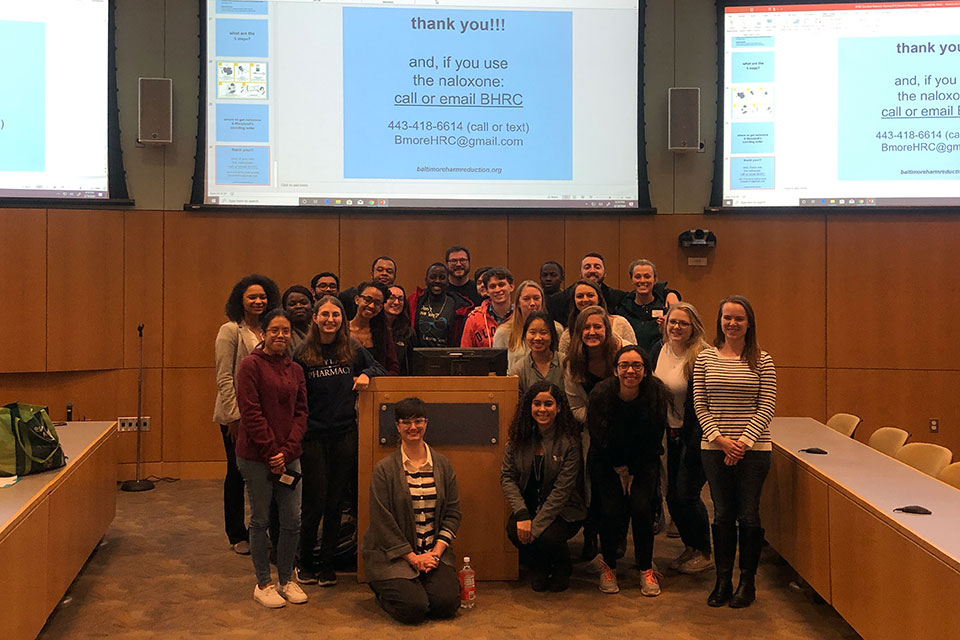Preparing Student Pharmacists to Treat Opioid Overdoses
March 03, 2020 Suchi Shah
Student organizations come together to deliver opioid overdose response training to student pharmacists.
If you ask any student pharmacist what topic they hear most about in school, I guarantee 90 percent of them would say the opioid epidemic. As a student pharmacist in Baltimore, I hear about it at least two to three times per day.
The opioid epidemic refers to the increasing number of deaths caused by the use of prescription and illicit opioids, such as heroin, hydrocodone, oxycodone, and fentanyl. The epidemic started in the 1990s, when pharmaceutical companies began to market new opioid drugs as a revolutionary way to treat chronic pain, encouraging doctors to prescribe more of these drugs. According to statistics published in 2019, more than 130 people died each day from an overdose, with 47,600 total deaths caused by opioid overdoses in 2019. In addition, approximately 81,000 people were reported to have used heroin for the first time, further illustrating the dramatic rate at which this epidemic continues to spread.
A Desire to Help Others
As a student pharmacist, when you hear about the monumental impact these drugs now have on society, you feel like it’s your duty to do something about it. This is how the Opioid Overdose Response Training became an annual event at the School of Pharmacy. While we cannot stop every person from using opioids, we can make an impact by getting educated and advocating to others about naloxone, more commonly known as Narcan®.
Naloxone is an opioid antagonist that works within minutes when administered to someone experiencing an opioid overdose. It is the only drug known to prevent opioid-related deaths and, as pharmacists, we learn about its clinical effects during school. So, why not also learn how to use it?
Hands-On Training to Save Lives
Every year, the American Pharmacists Association-Academy of Student Pharmacists’ (APhA-ASP) Generation Rx, Students Promoting Awareness (SPA), and the College of Psychiatric and Neurologic Pharmacists (CPNP) collaborate to host a training session designed to provide pharmacy students with insight on the opioid epidemic and certify them in naloxone administration. This year, faculty and students from other schools were also invited to attend.
We also collaborated with the Baltimore Harm Reduction Coalition (BHRC), a community-based organization that implements public health services and advocates for policies to expand harm reduction in Baltimore and across the state of Maryland.
The main activity included in this training session is a lecture led by one of the BHRC members. The lecturer reviews updated statistics on the epidemic published in the past year, talks about the various opioids that are being used, and most importantly, teaches us how to detect and respond to an opioid overdose. The presenter takes us through a step-by-step approach to help participants recognize the signs and symptoms of an overdose, what to say when you call 911, how to safely position the person to lay a certain way on the ground, how to administer CPR, where to inject the naloxone, and all of the steps in properly administering naloxone.
The training offers an extremely interactive and energetic approach to learning such valuable material, which is why we always collaborate with BHRC, as its staff are well-trained to effectively teach student pharmacists and others the value of proper naloxone administration.
Start Small to Tackle Big Problems
After attending and coordinating this event for the past three years, the most important lesson I hope participants gain is an understanding that every little action counts. Renowned activist Martin Luther King Jr. once said, “If I cannot do great things, I can do small things in a great way.” No one person has all of the knowledge and skills needed to combat the opioid epidemic. No single person can stop the use of opioids or eliminate the distribution and use of heroin in society. However, by being naloxone certified and educating community members about safe medication practices and how to use naloxone, we can have a far greater impact than we would by sitting on the sidelines and taking no action at all.